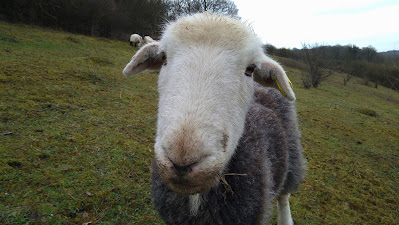Fantastic Sheep and Where to Find Them
It's no secret that I'm a big fan of farm animals. With lockdown a year ago, I couldn't travel to city farms to get my animal fix, so I had to look closer to home. This post is a celebration of Croydon's sheep and a guide to where to find them, although sheep are moved around as necessary through the year. Goats and cows are also used for conservation grazing on some sites but I'll cover them more in another post.
Sheep are naturally nervy but the ones round here are generally pretty tame and curious and their characters shine through.
If you do see sheep, please don't feed them and please keep your dog on a lead anywhere where there are sheep grazing, even if you think your dog isn't a threat to the sheep. There have been incidents where dogs have found their way into the fields and seriously injured and even killed sheep in Croydon.
Croydon Ecology Centre, based at Heathfield Gardens, has an orchard with two resident sheep. They're pretty friendly. The ecology centre is normally open on certain Sundays and for special events through the year but it's been closed to the public because of Covid. However, you can often see the sheep from the picnic area in the orchard or through the gate in the walled garden.
To find out more about events at Heathfield when lockdown is over, take a look at their Twitter feed, website or join their Facebook group.
There are two organisations (that I know of) using farm animals on a larger scale for conservation grazing operating in the Croydon area. Conservation grazing is a natural alternative to mowing grass, using a carefully balanced density of grazing animals. Without grazing, the grass downland habitats which support a variety of wildflowers, butterflies, other insects and birds would revert to scrub and eventually woodland. We have these grazers to thank for the diversity of wildlife at our important chalk downland sites such as Hutchinson's Bank, Riddlesdown, Farthing Downs and Roundshaw Downs.
The Downlands Grazing Partnership manage a large number of sheep, plus a smaller number of goats and Sussex cows, across various sites in the Croydon, Sutton, Bromley and Surrey areas. You can learn more about their animals and where they are on their Twitter feed or Facebook page.
Some of Croydon's best known large green spaces are owned by the City of London Corporation. They have a large number of cows and sheep that graze across Farthing Downs and Riddlesdown.
 |
| Riddlesdown |
Some of the sheep breeds you may see in Croydon's green spaces include:
Jacobs sheep
 |
| Jacobs sheep at Riddlesdown, 2013 |
These beautiful sheep with their dark brown/black and white wool and curved horns are thought to have originated in the Middle East, where they are referenced in the Old Testament book of Genesis.
 |
| Jacobs sheep at Riddlesdown, 2020 |
Beulah speckled face
These sheep are originally from Wales. They don't have horns and their faces and legs are speckled black and white, while their wool is white.
They can be seen at Hutchinson's Bank, where they are well suited to grazing the hillsides.
Herdwick
Native to the Lake District, these hardy sheep have thick straight grey wool and fuzzy white faces. The lambs are black but gradually lighten in colour. The author Beatrix Potter was a big fan and bred prizewinning Herdwicks in the 1930s. They can be found at Hutchinson's Bank and in the orchard at Croydon Ecology Centre.
Portland
These sheep are quite small, with both sexes having curled horns. They originated on the Isle of Portland in Dorset. The males (above) have double curled horns which look a bit cumbersome, while the females have shorter, more practical horns (see below). They have cream fur and golden brown coloured legs and faces.
There's currently a flock grazing at Riddlesdown.


















I love sheep!
ReplyDelete